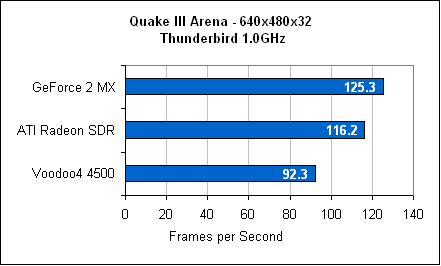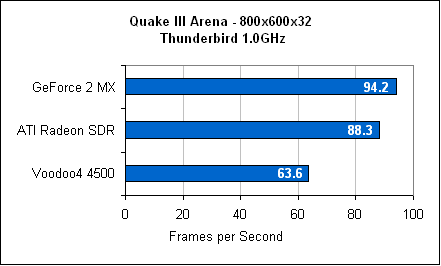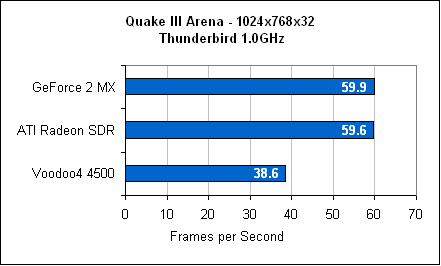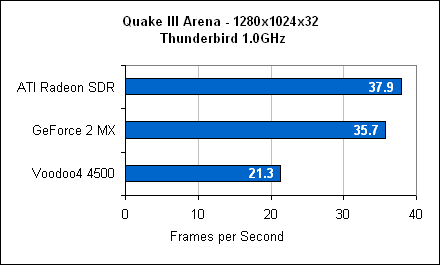Budget Video Card Comparison - November 2000
by Matthew Witheiler on November 27, 2000 3:20 AM EST- Posted in
- GPUs
Quake III Arena Performance

As we have noted many times in the past, two main issues factor into a card's 640x480x32 performance when tested on the same CPU. These factors are T&L performance and driver maturity. Since the cards we are looking at here all have a rather mature driver base (as they all use essentially the same drivers as their older, higher performing counterparts), we can narrow the differences between the cards to the T&L engine. This serves to explain the rather lackluster performance of the Voodoo4 4500, as this is the only card on the list that does not have any T&L support. It is for this reason that the GeForce2 MX and the ATI Radeon SDR differ by only 7.8% percent while the Voodoo4 4500 falls behind the Radeon SDR by a full 25.9% percent. The 7.8% speed difference between the ATI Radeon SDR and the GeForce2 MX shows that the Radeon's Charisma T&L engine may not be up to the par of NVIDIA's.

Although the 800x600x32 resolution is normally left out of our video card comparisons, in the case of budget video cards it is often the resolution of choice. Running on the 1.0 GHz processor, the cards had no problem running up to speed at this resolution. We found that while the Voodoo4 4500 is crippled, both by its lack of power as well as its lack of T&L support, both the Radeon SDR and the GeForce2 MX perform similarly.

At 1024x768x32, the line between the second and first place cards is nearly nonexistent. The GeForce2 MX ends up beating the ATI Radeon SDR by a mere .3 FPS; a speed increase that is completely unnoticeable in any game. The reason that the Radeon SDR is able to catch up to the GeForce2 MX is unquestionably due to HyperZ technology. Since increasing the resolution puts significant strain on the memory bus, both the GeForce2 MX and the Voodoo4 4500 begin to suffer from memory bandwidth limitations. ATI's HyperZ technology, on the other hand, allows the Radeon SDR to continue to scale well at higher resolutions simply due to the fact that the memory bandwidth bottleneck is not as large of a problem.
Although the difference between the Radeon SDR and the GeForce2 MX is gone, the difference between these two cards and the Voodoo4 4500 is quite large. Both the Radeon SDR and the GeForce2 MX dominate the Voodoo4 4500 by a large 55%. In fact, it is for this reason that it was necessary to include scores at 800x600x32, since many Voodoo4 4500 users will choose this resolution over 1024x768x32. The 38.6 FPS that the Voodoo4 4500 supplies here may not be enough to satisfy many gamers.

The final resolution we will investigate in this comparison is 1280x1024x32. Once again, this is not a resolution commonly included in our video card tests. The reason it is included here is that for every value card currently out there, this resolution serves as the maximum playable resolution in nearly all cases. At 1280x1024x32, the Radeon is able to take position as top card, once again thanks to HyperZ technology. The problem is that even this card performs at 37.9 FPS, a speed which is unplayable for many.










0 Comments
View All Comments